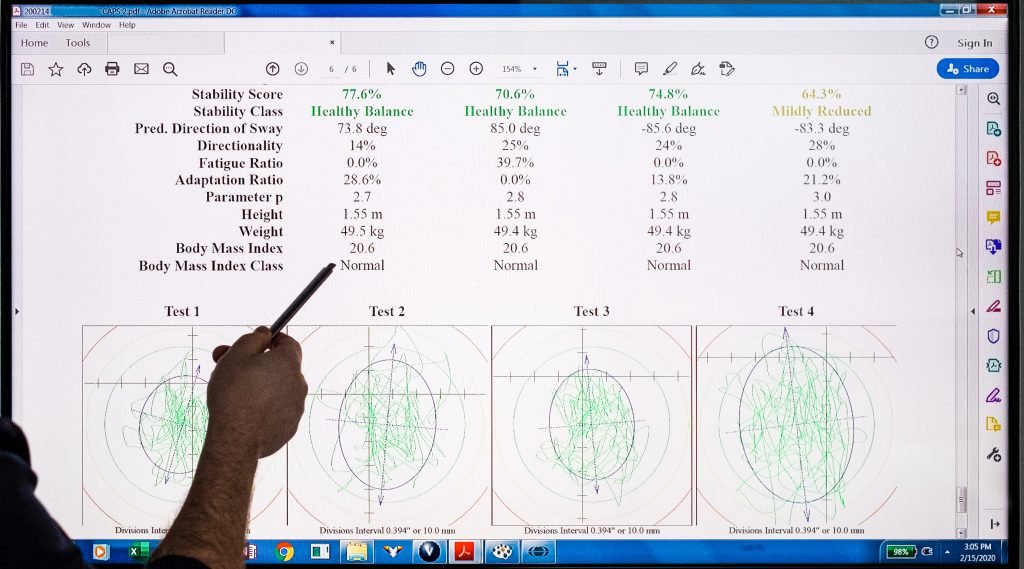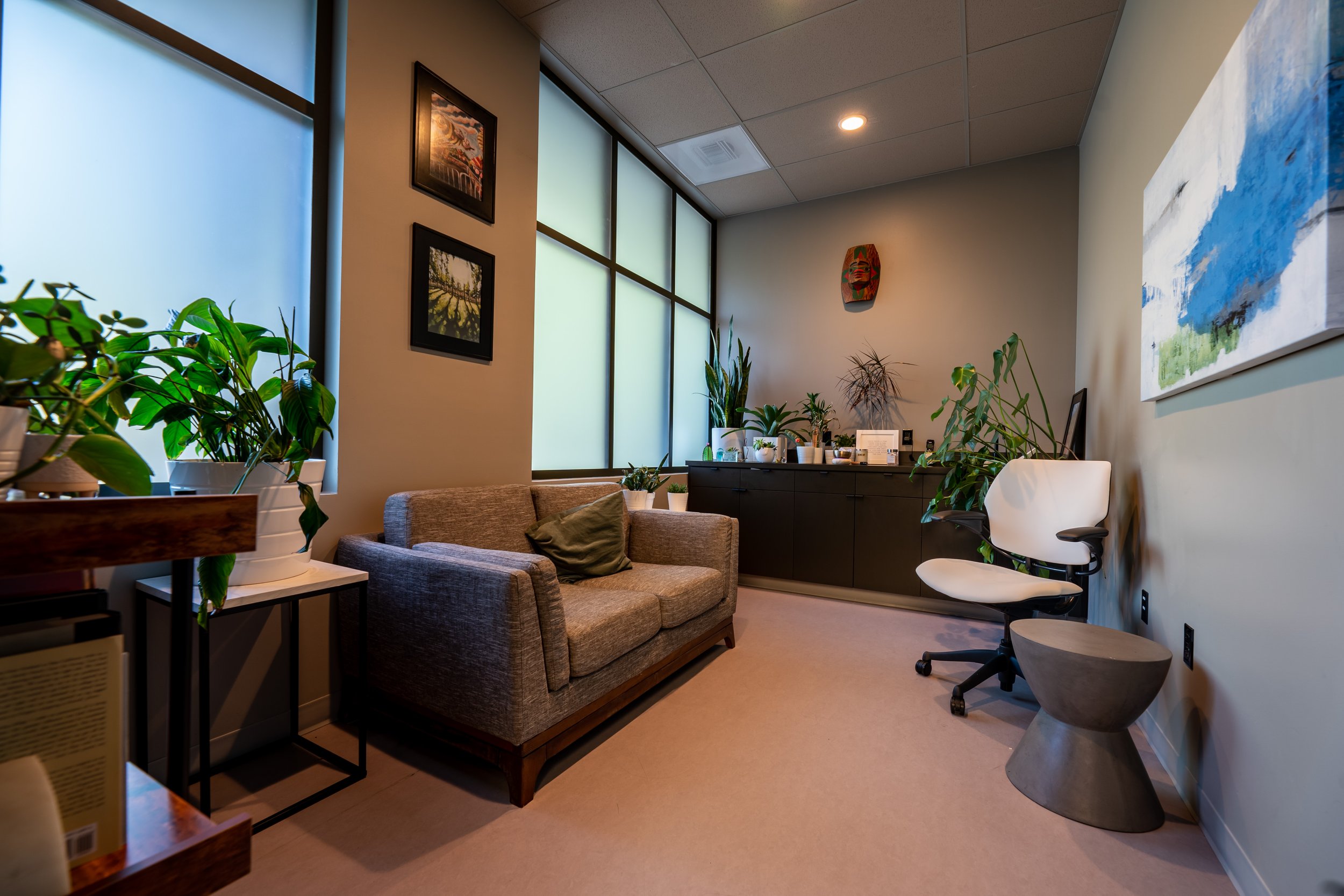
COMPUTERIZED POSTUROGRAPHY
WHAT IS COMPUTERIZED POSTUROGRAPHY?
Computerized Posturography is a tool we can use to objectively assess your ability to balance and remain stable as you move through the world. We use the Vestibular Technologies Comprehensive Assessment of Postural Systems (CAPS) force plates for this aspect of our neurodiagnostic testing. Our CAPS systems are research-grade devices that are sensitive enough to read your heartbeat through your feet. Our CAPS protocols allow us to evaluate every system involved in your ability to balance, as well as how they work together in different sensory conditions. This shows us not only how well these systems work, but what we need to do to get them working well and in harmony again.
HOW DOES CAPS TESTING HELP ME?
The ability to control your balance is critical for anyone that wants to function properly in the world. Balance control requires input from the eyes, the inner ear, and feedback from muscles and joints. The brain needs these inputs to be saying the right things about where the body is in space at all times. It also needs to be able to shift emphasis between all of these systems rapidly and effectively to maintain balance in a dynamic sensory environment.
When any of these pathways are impaired, or the ability to properly integrate them is lost, balance is compromised. Higher brain centers can help us compensate for impaired balance, but this requires sacrificing some degree of higher brain function. As a result, it is common to see some level of motor, cognitive, and even emotional regulation lost as the brain struggles to make sure that you don’t fall down. We see impaired balance in all manner of neurological conditions, including:
Concussions & Traumatic Brain Injuries | Dizziness & Vertigo | Movement Disorders | Neurodegenerative Disorders | Dysautonomia | Peripheral Nerve Disorders | Neurodevelopmental Disorders | Chronic Pain | Strokes & Vascular Disorders | Mental Health Conditions | Cognitive Difficulties
WHAT TO EXPECT:
CAPS testing is very simple. It only requires that you stand still on one of our force plates for 60 seconds. As we all try to balance and hold still, our bodies will have some level of sway. The computed records the precise location of your center of pressure on the plate, and traces how this moves as you sway and try to stabilize.
We test you in a number of sensory conditions. We start with your eyes open with your head in a neutral position on a stable surface, and progress to testing your eyes closed on an unstable surface with your head in different positions. Depending on your condition, we may perform as many as 16 different balance tests in total.
FAQs
-
CAPS testing is extremely safe. When your balance is compromised, there is always a risk that you may fall during the testing. Because of this our technicians are always very close by, and stand ready to stabilize you if you begin to lose your balance. Our tests are designed to get progressively more difficult. They will always stop the testing progression if it is not safe for you to continue.
-
Balance requires proper function of the eyes, inner ear, and feedback from muscles and joints. If any of these receptors are damaged or degenerate, balance can become impaired. All of these receptors require neurological pathways to conduct their input into the brain. Damage or degeneration of any of these pathways can also lead to a balance deficit. They need to integrate in a number of central regions including the brainstem and cerebellum, as well as the parietal and insular cortices.
Damage or degeneration of any of these systems can likewise impair balance. Ultimately your brain uses its awareness of where it is in space to fire stabilization reflexes through the motor system. Any damage or degeneration involving motor stabilization pathways, or the higher brain systems that control them, can also lead to balance difficulties. Balance can become impaired in just about any neurological condition.
-
CAPS testing shows us how your center of pressure sways on the force plate as you attempt to hold still. It exports this as a graph of your ellipse of sway, which shows us what strategies you are using to maintain your balance. It gives you a Stability Score, which is based on normative data for your age. It categorizes your stability in terms of a range from healthy balance to profoundly reduced.
Our series of tests allow us to see how well you can make sense of feedback from your ankles, your eyes, and your inner ear. The different combinations of sensory inputs used in varied tests shows us not only how these systems work, but how well they work together. It lets us see where your sensory mismatches exist, and when your systems fatigue or fail. This shows us exactly what we need to do in order to get all of the different components of your balance system working again and working well together.
-
Yes, in most cases. While we cannot ever guarantee results, we are usually very successful with resolving complicated balance issues.
Our approach is significantly different from traditional balance therapy. Conventional rehab seeks to train your brain to compensate for problems in your visual, vestibular, and proprioceptive systems by exposing you to progressively harder balance challenges. Our approach is to first identify the specific visual, inner ear, and proprioceptive reflexes that are creating your balance problem, using our cutting-edge neurodiagnostic testing systems. We begin by rehabilitating the impaired reflexes directly, then get them working in concert with each other. Only then do we begin balance exercises. We find this approach to provide faster results, better outcomes, and more lasting improvement.
LET’S GET YOU BACK TO LIVING YOUR BEST LIFE
“Now I have hope and am very grateful, I thank Doctor Zielinski for his work.”

-
We use advanced neurodiagnostic technologies and cutting edge neurorehabilitation strategies that are unique to your brain and condition.
-
We use high frequency treatment over 5-10 days, to bring you maximum results in the shortest time possible.
